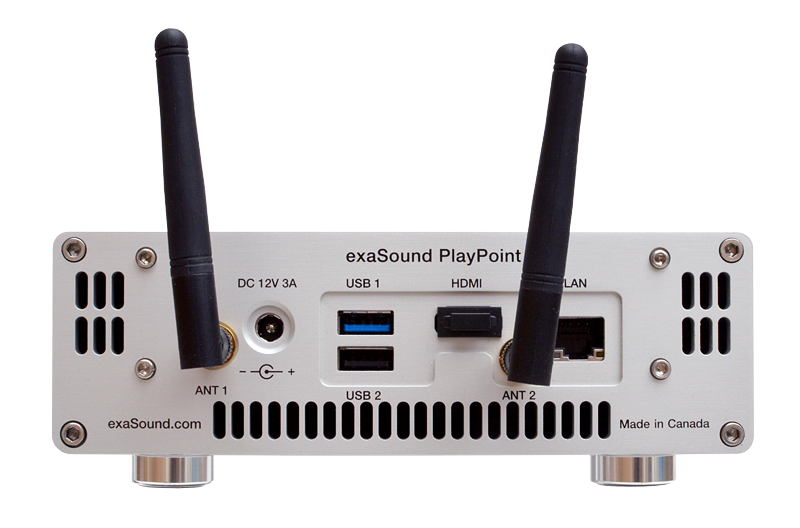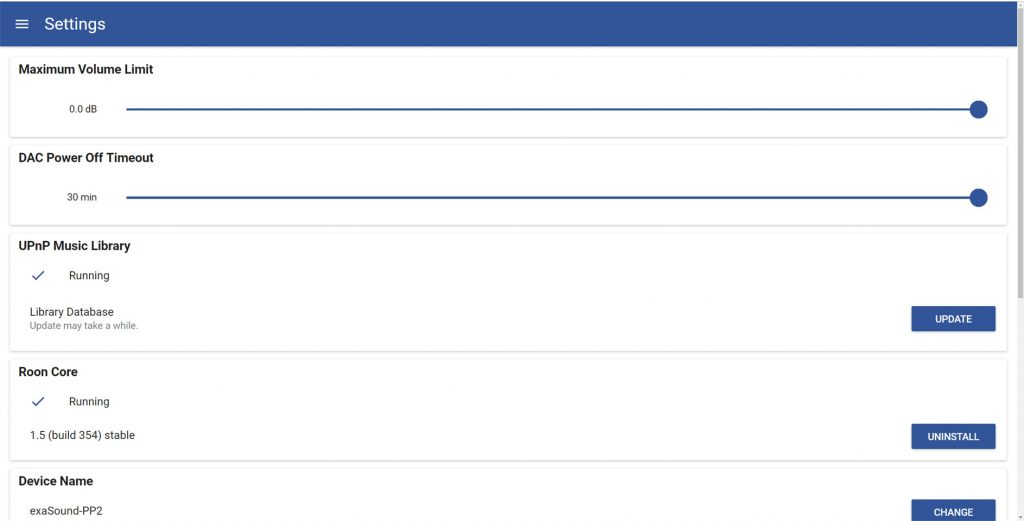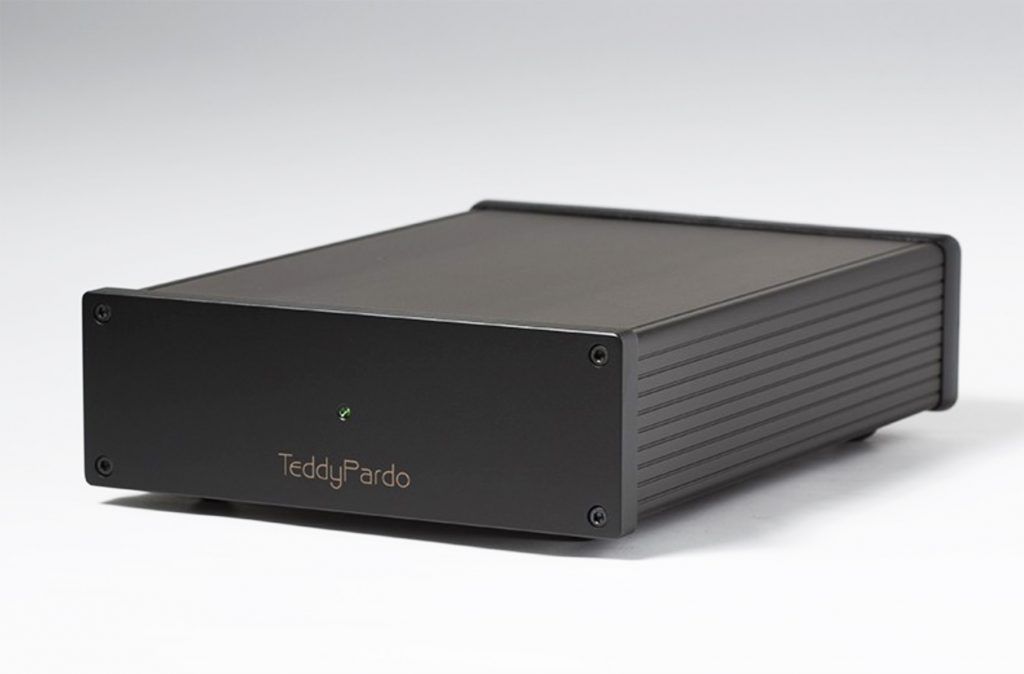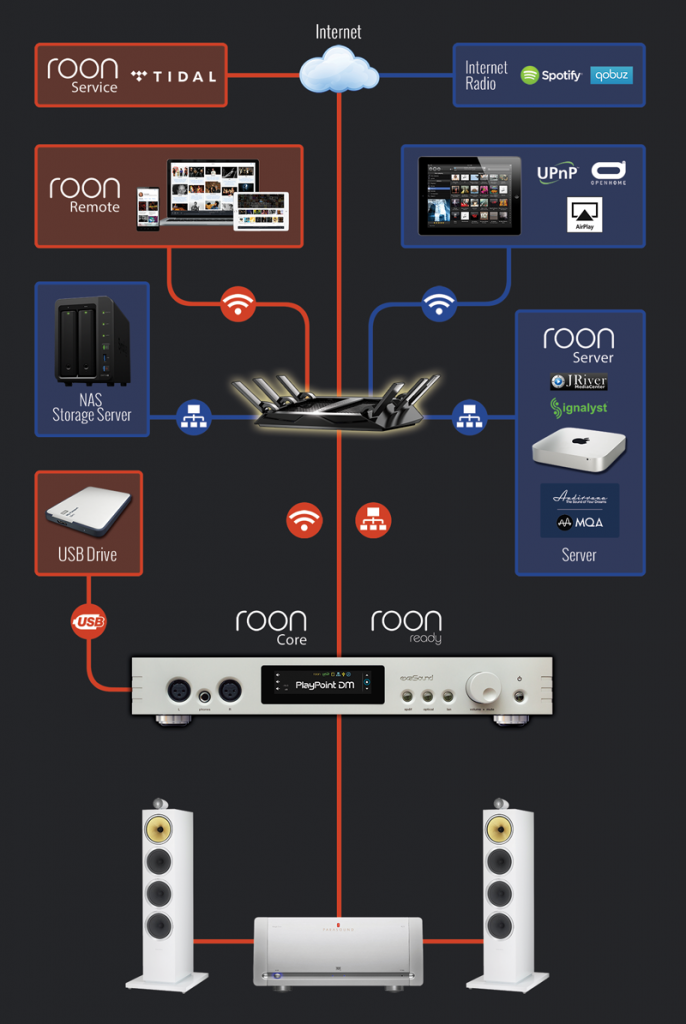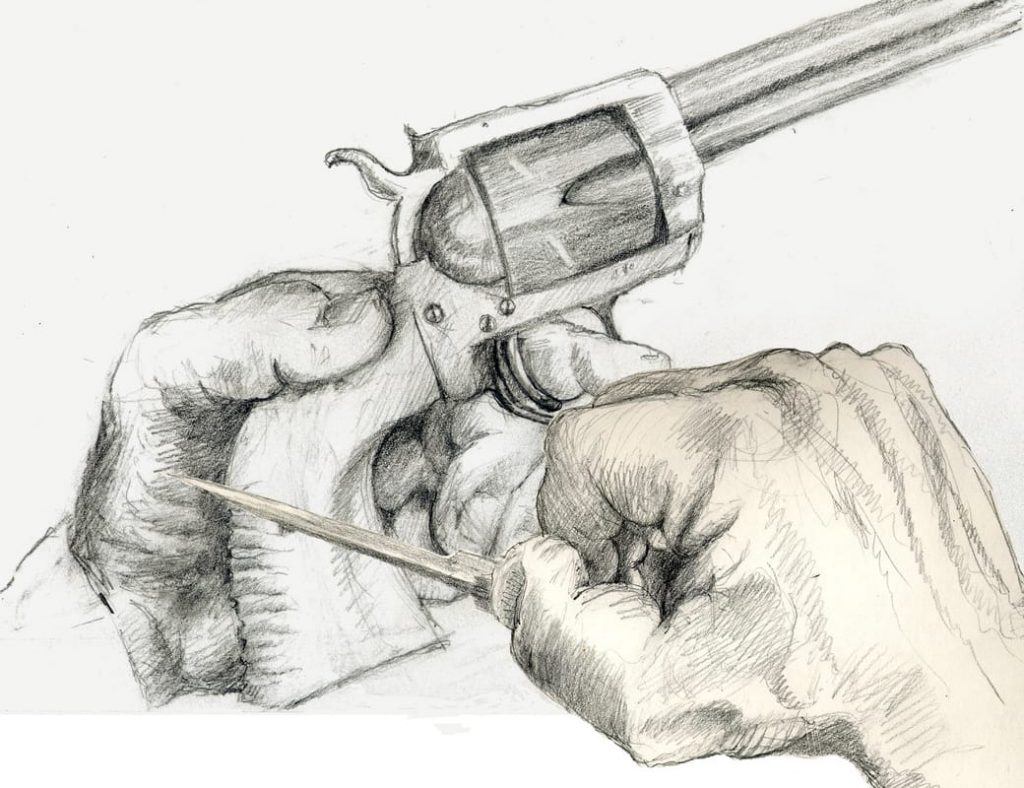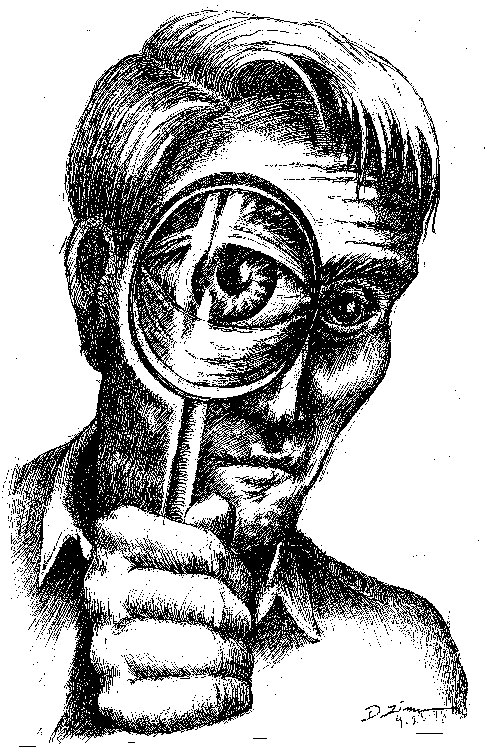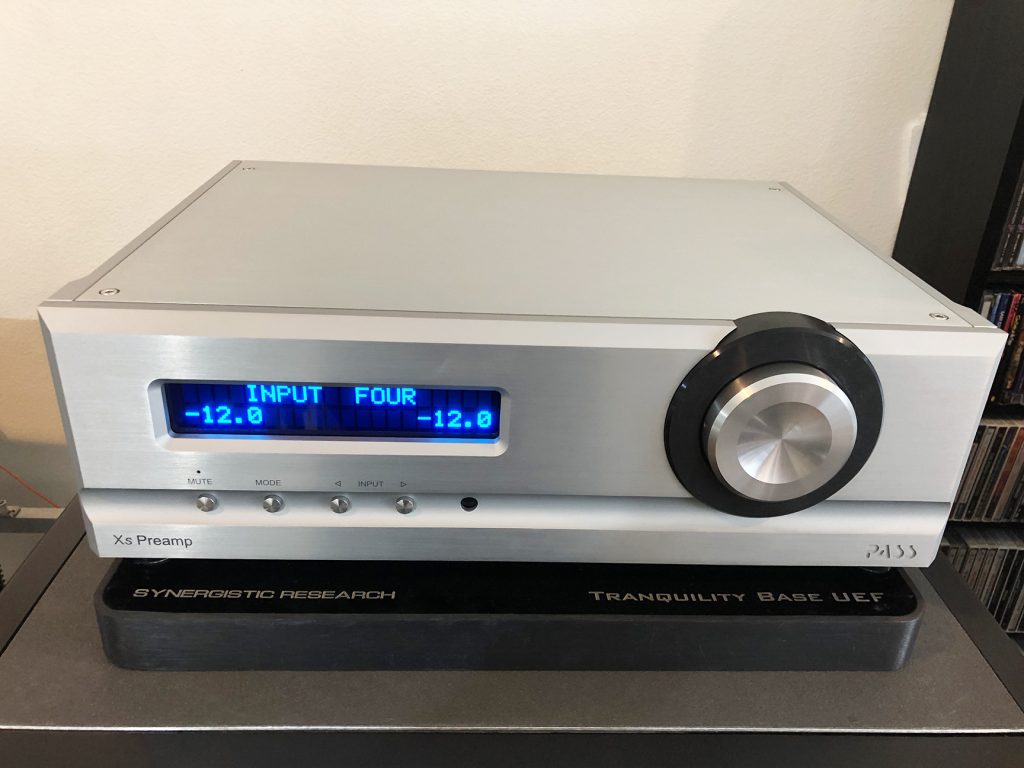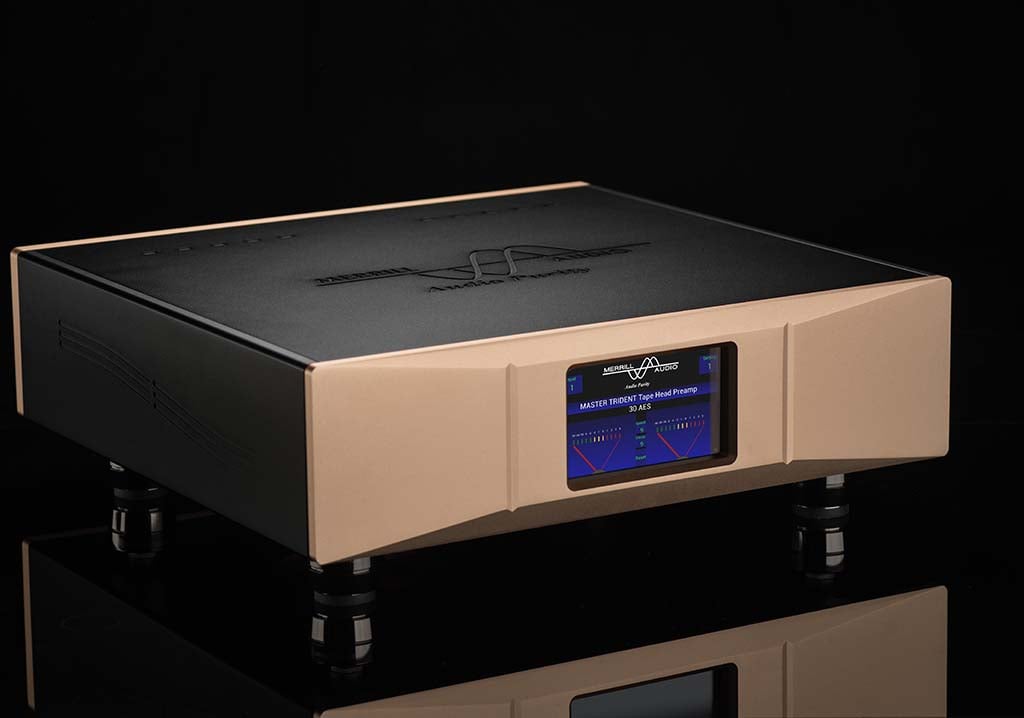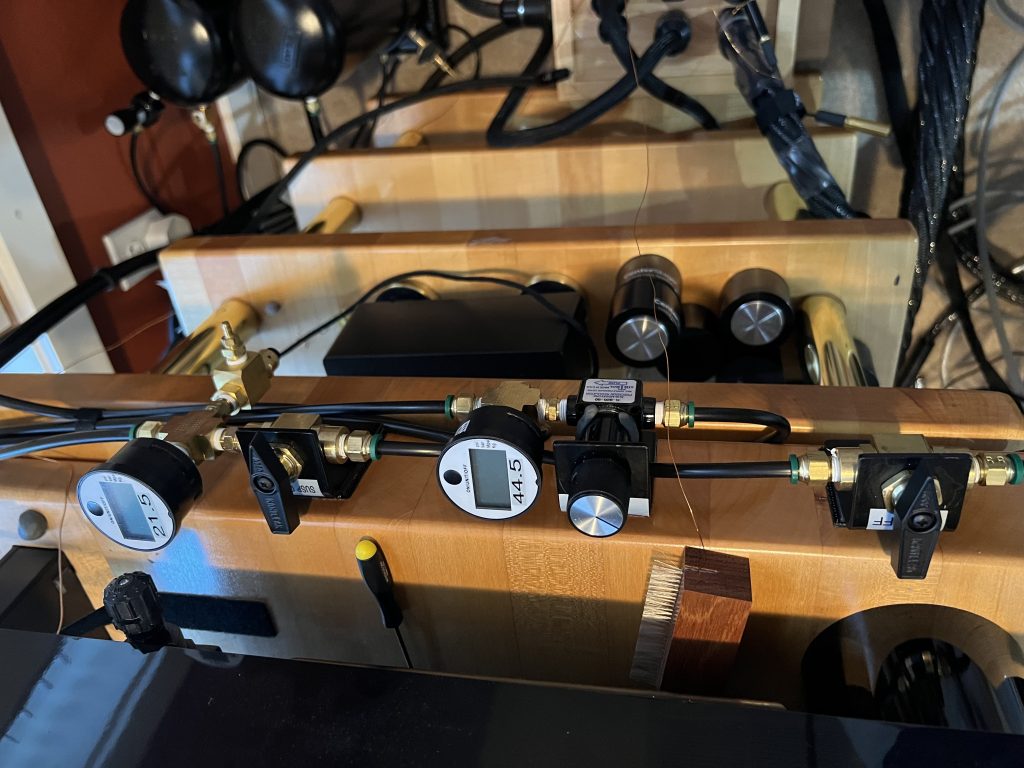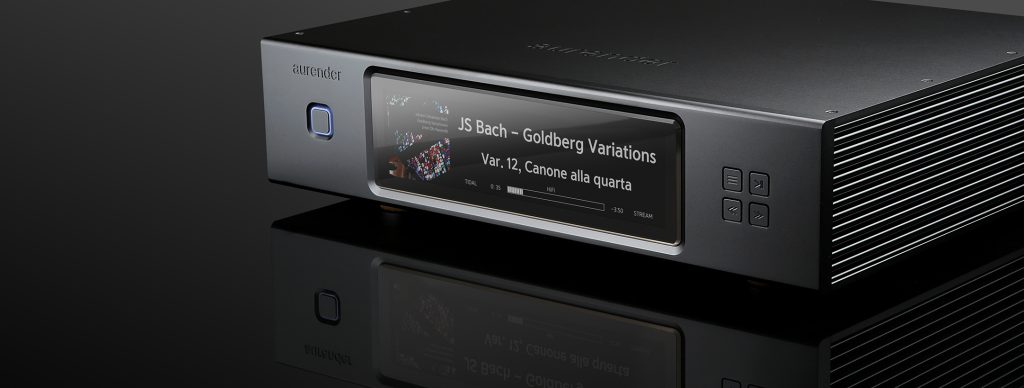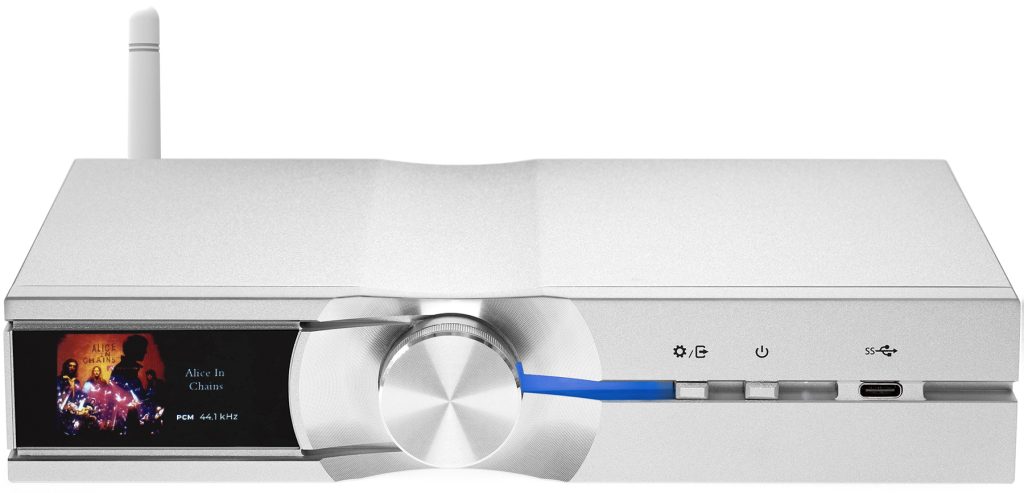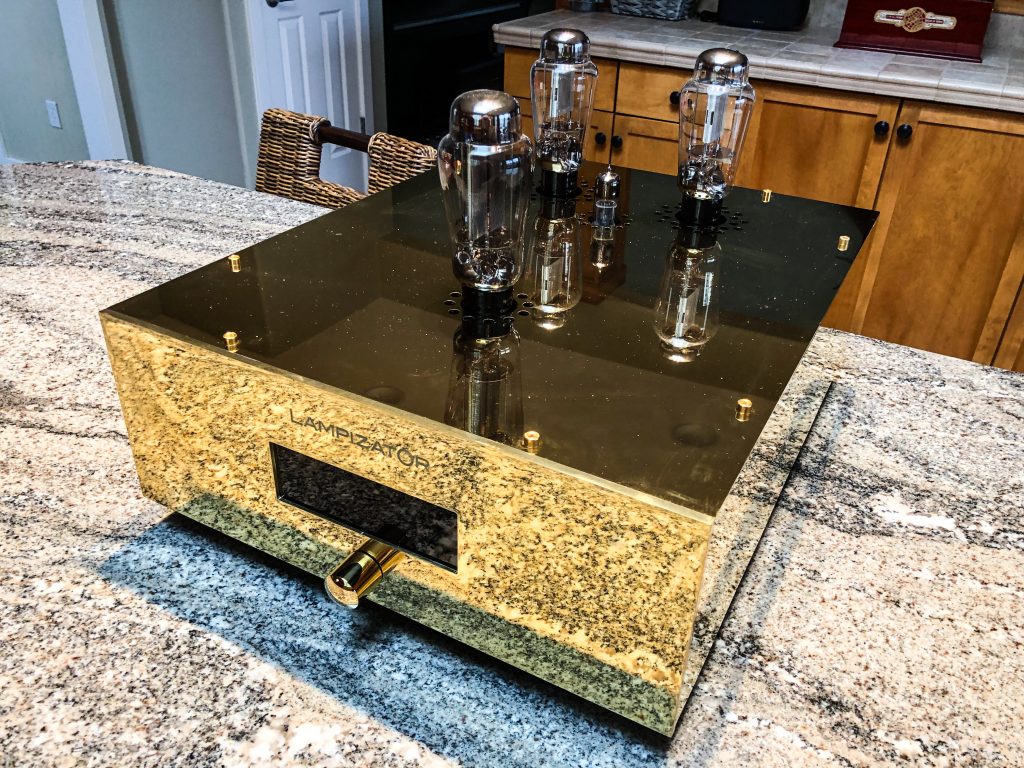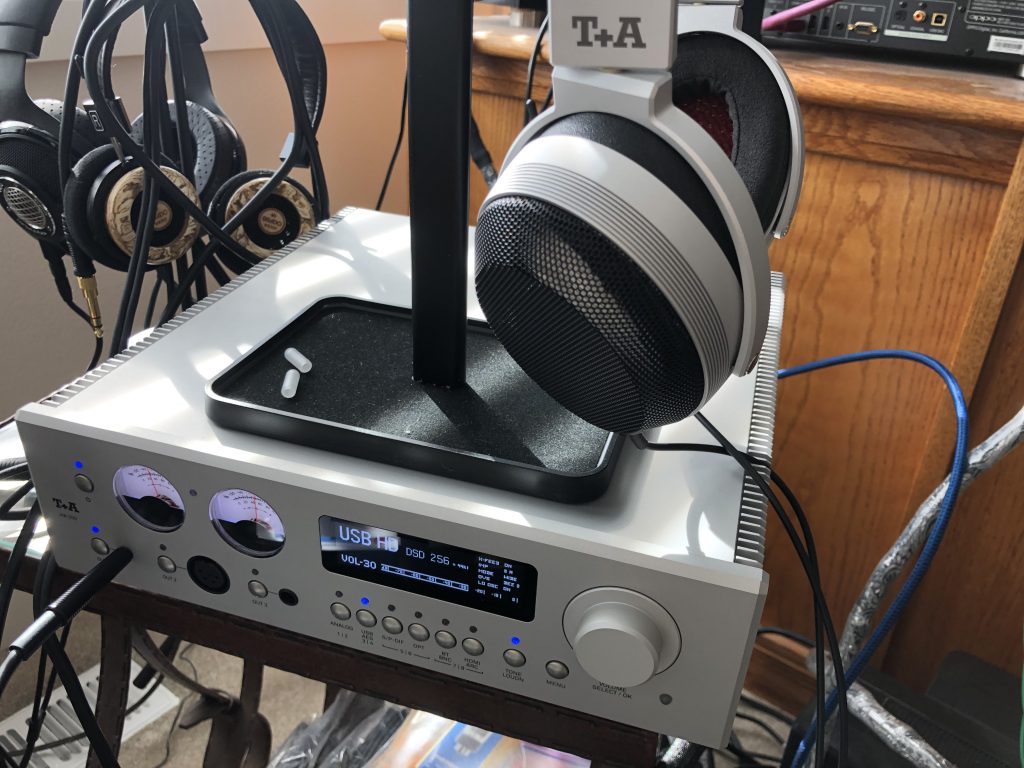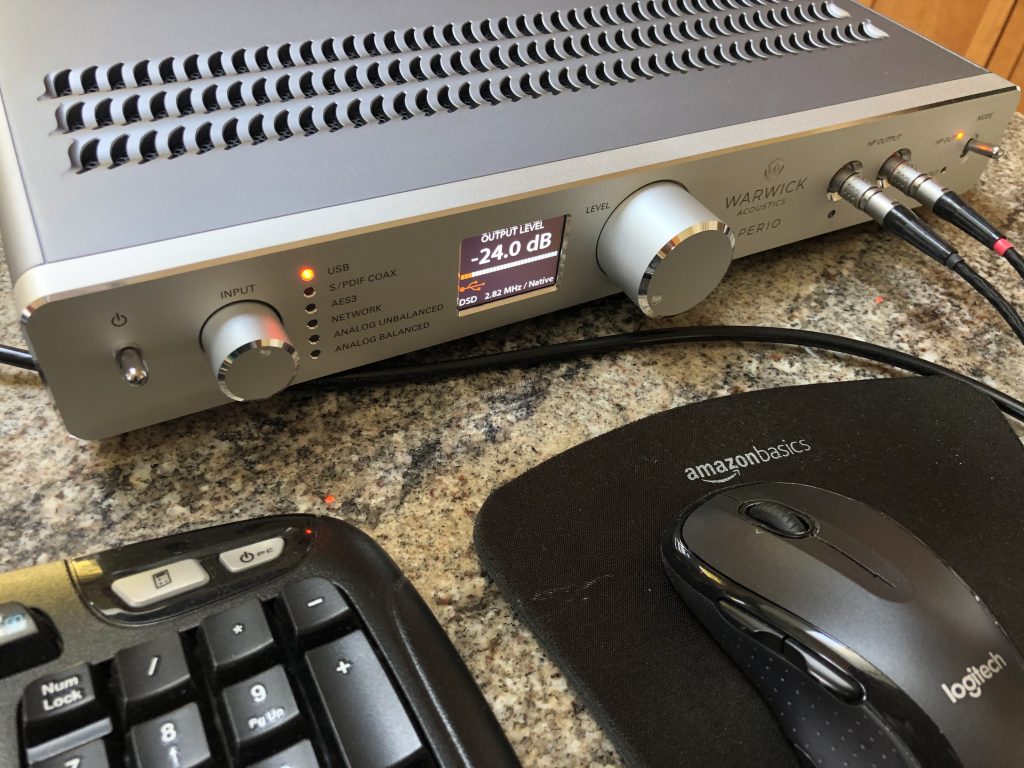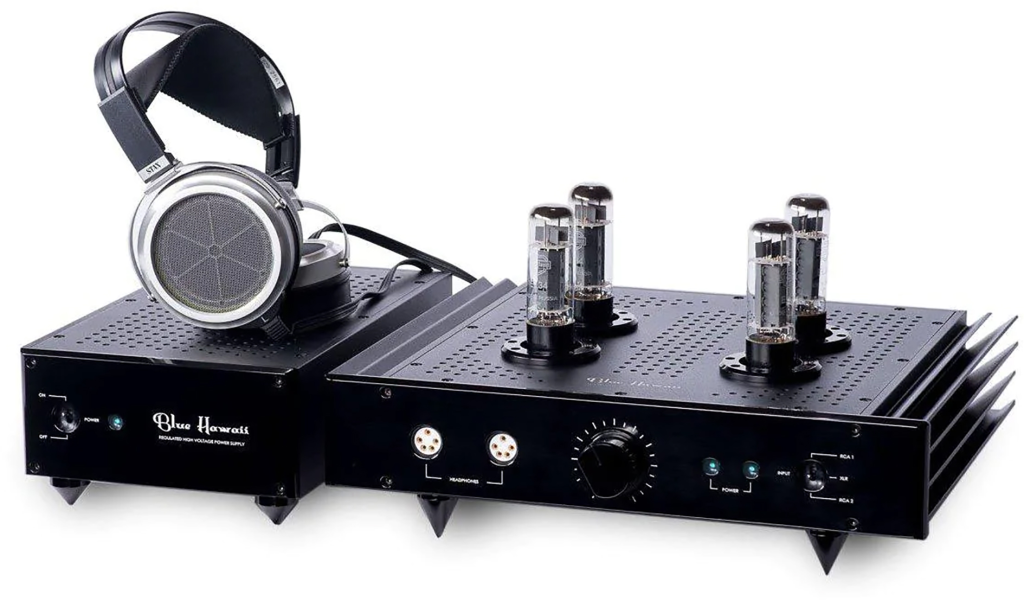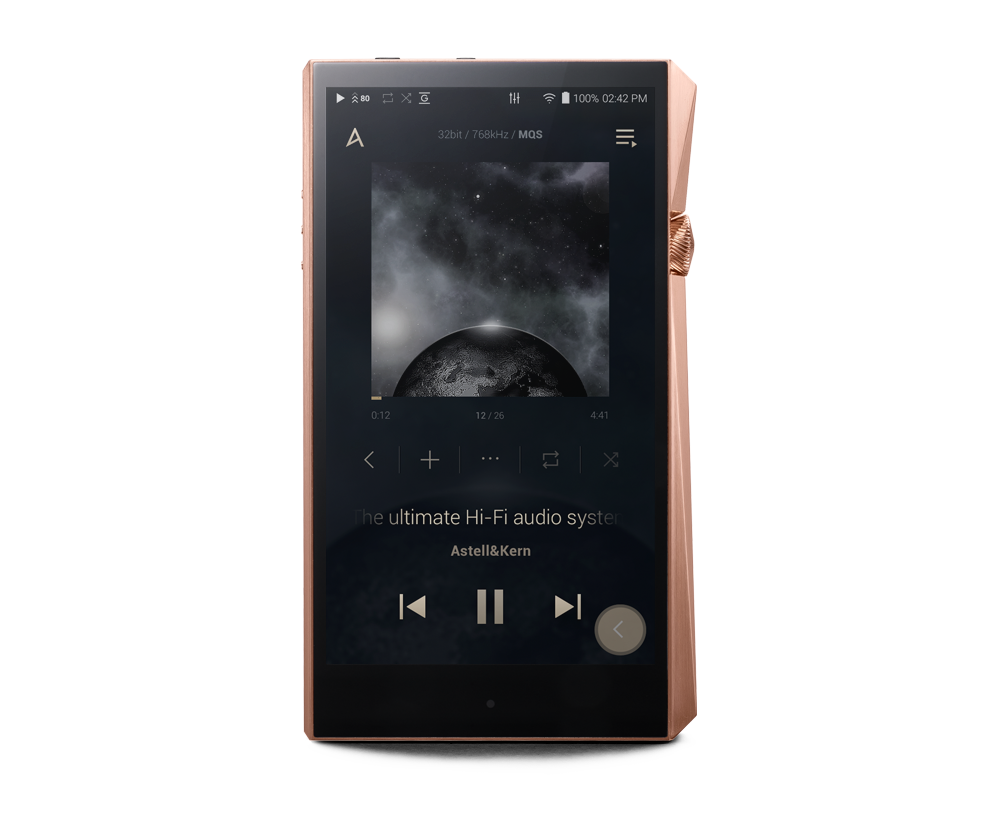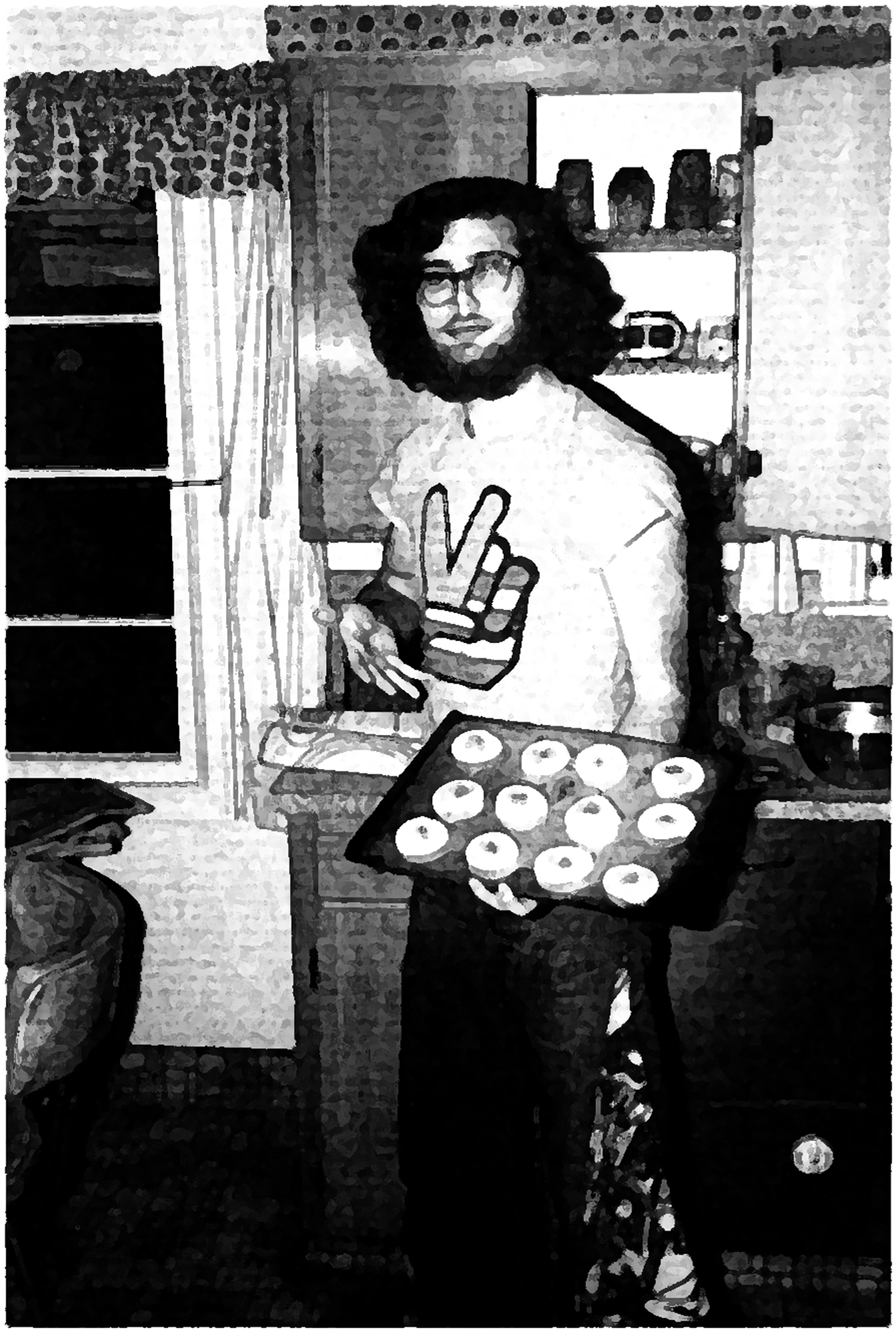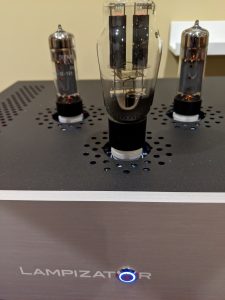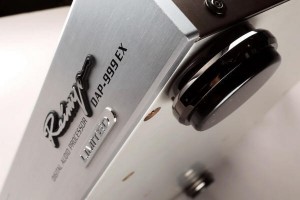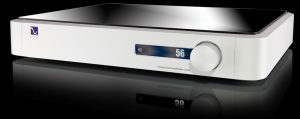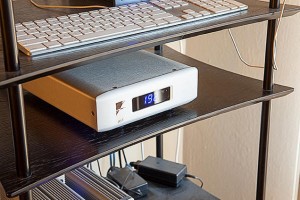Ye Olde Editor with pipe weed. Portrait by John Robinson.
This seems to be a season for culminating projects. Given that autumn is upon us now, I reckon that the time matches the season, and the mood matches the moment.
Having finished my summing up of the Audionet STERN and HEISENBERG reference products, it is time to turn my attention to another reference-level product that arrived earlier this year: the exaSound DM (Dual Mono) Reference Network Audio Server and DAC.
But first, a walk down audio memory lane.
George Klissarov of exaSound in his room at AXPONA 2017
I met George Klissarov years ago…2013, as I recall…at one of the audio shows that year. I was immediately taken by the quality of the sonic reproduction of his design work, and by the fact that he was committed to bringing the very best out of DSD. He was demoing with a new of excellent DSD recordings, showing excellent taste and discernment in his choice of albums and music. He was pleasant, professional, and quite knowledgeable about getting the finest sound possible with his products, all the way out to Quad DSD.
The exaSound e32 Quad DSD DAC
Since then, I'm pretty sure that I've heard or evaluated just about every DAC that exaSound has released. Lessee now: of DSD DACs, the e20 stereo (see my review back in Issue 67, May/June of 2013, right HERE), the e22 stereo (auditioned and awarded one of my Audio Oasis! Awards at RMAF 2014…see it HERE), the e28 8-channel (see my Impressions evaluation in Issue 73 back in May/June of 2014, right about HERE)…
The exaSound PlayPoint Network Audio Player
…the PlayPoint Network Audio Player (a Brutus Award winner in 2016, as you'll see HERE), and their latest generation e32 stereo (another Brutus Award winner; see HERE) and e38 8-channel Quad DSD DACs (at shows and also here at PF Central).
So I've spent many hundreds of hours with exaSound over the past five years, and know the superior audio virtues of their products quite well. (You can read the linked content above to see what I've had to say.) In sum, the exaSound line, based on a highly optimized utilization of the industry DSD standard 90xx ESS Reference 32-bit SABRE32 DAC, is visually attractive, nicely compact, and balances great detail and transparency with excellent dynamics and a very seductive musicality in its sonic presentation. I have gladly climbed the exaSound mountain over time, because each new ridge was better than the old, and brought a very high degree of audio resolution to our growing reference library of great DSD recordings at all levels: Single, Double, and (especially) Quad DSD.
Price? Did I mention price?
exaSound impressed me from the beginning by producing the quality of sound that I've described, and doing so at very attractive (for high-end audio) price points. USD $2K to $3.5K? Exceptional! It made it possible for audiophiles and music lovers to experience serious the performance and musicality that DSD brings to the game without having to sell spouses/offspring to pay for it all. And there's nothing like winsome pricing to tempt the wandering 'phile, eh?
Drivers? Did I mention drivers?
I have found real variability in the quality of the drivers for DACs over the years…especially DSD DACs. Some DACs are limited in what operating systems they'll support, or will suffer performance/reliability issues over time. Yes, some product samples get shipped with drivers and setup packages that simply don't work. You won't read about those here; those DACs go back to Daddy for regrooving without being published at PF.
Not ready for prime-time, you see?
Happily, this was never true of exaSound's designs. As a longtime Information Technology guy myself, I really appreciate superior drivers. In audio, great drivers will provide rock-solid operation, will shift resolutions smoothly on the fly, will be stable under load, and will help to bring out the best of what the DAC is doing with the audio feed.
Bad drivers just make you feel like taking a sledgehammer to the DAC and going out to lick your wounds over drinks, more drinks, and a cigar.
So kudos to George and company for never tempting me to reach for my Thor mallet with their e-series DACs.
But then came something new…
Last year George told me that exaSound had something radically new and different in the works. He was at work on a reference-grade product that would pull everything that they had learned from the e-series DAC and the PlayPoint Network Audio Player, execute it without the earlier price constraints, and produce it as a unique product in their lines. Was I interested?
Uh…yes!
And so earlier this year, George notified me that he was ready to ship a review sample of his new top-of-the-line product: the exaSound PlayPoint DM Dual-Mono D/A Converter and Network Audio Server.
It was a true single-box dual-mono configuration, featuring two ESS ES9028PRO 8-channel DAC chips, running in 32-bit octo-mono configuration. This puts the processing punch of each 8-channel chip into a single channel. (For a summary of the exaSound DM from George Klissarov himself, see the sidebar article directly under this one.) Left and right channels are separate within the attractive anodized silver, black, or even zebra finishes available for the chassis. For the record, the review sample that George sent to me was finished in black. Nice! Along with it came the Pardo Power Supply, which…having tried Pardos as an upgrade with our e32 stereo DAC and PlayPoint Network Audio Player for many moons now…I consider to be an absolutely essential addition to exaSound DACs. If you're buying an exaSound e-series DAC, make sure to get the Pardo Power Supply, as well. If you already have one with the standard power supply, contact exaSound to purchase the Pardo Power Supply as an update.
You can thank me later.
The Pardo is not optional on the DM, however; it's the only power supply that you get.
The front panel has headphone jacks for both ¼" cannon and left/right balanced operation. There is a very colorful and crisp control display amidships, and then input select buttons for SPDIF, optical (TOSLink), and LAN (Ethernet). A volume knob with muting and the power button to the far right round out the show.
The exaSound PlayPoint DM at PF River City (right), with its accompanying Pardo External Power Supply (left)
The exaSound DM is a RoonReady player, which means that it operates at the highest level of Roon integration. It was certainly hassle-free for me in that regard; linking the DM to our Roon and Tidal accounts was very straightforward.
The DM also has a Web interface tool embedded in the unit that allows you to configure and monitor your DM via the browser on your computer…very handy, that. (You have to be on the same subnet, of course, if your household has multiple subnets. Mine does.) Its functionality runs several sub-screens deep, and has most everything that you'd want to have to configure or adjust your DM from your computer.
Rear view of the PlayPoint DM: a solid set of inputs and outputs
Same view, in black, with the wireless wings attached
The DM has a very useful set of I/O on the rear of the unit. Ethernet, two USB ports for hard drive inputs, TOSLink in, S/PDIF RCA in, RCA analog out, XLR analog out, mini-pin power supply (what the Pardo is plugged into our the sample here), and a pair of 12 volt multi-pin inputs for a switching mode power supply.
Our sample unit came with the Pardo Power Supply, and it's been sounding brilliant, as you'll see in my evaluation and conclusion below. I was curious about the switching mode power supply option, though, and asked George Klissarov about it. He responded via email and gave me the sort of direct answer that I've come to expect from George. "We no longer offer the switching power supply," he stated. He went on to say that their DM power supply "…is always the Teddy Pardo, and it is included in the price [USD $14,000]. The Teddy Pardo is better sounding and the difference can be correlated with noise measurements. Since [the DM] is a 'cost is no object' design, it is only logical to use the better power supply. The credit for the difference in design goes to Teddy Pardo. He uses a proprietary design based on discrete components that is very elegant."
That's that.
The DM is Roon-ready, which throws the door open to Tidal…in our case, Tidal HiFi, which gives us an enormous library of millions of streaming 44.1kHz/16-bit .FLAC tracks to listen to. (Great for musical exploration, research, and try-before-you-buy, I might add.) It also supports everything from compressed Apple files (AAC) to 384kHz/24 bit PCM and DXD at 352.8kHz/24-bit. Naturally, DSD is supported: Single, Double, and Quad DSD.
Wireless operations and connectivity, very important for some listeners, is also supported…options like Apple AirPlay and UPnP. Check the connectivity chart below for the schema of possibilities.
Overall, this is an impressive and well-thought-out package.
Specifications
Best to read these directly from the exaSound Web site:
- D/A Converter IC - 2xESS Technology ES9028PRO 32-bit, 8-channel. PRO series DAC in octo-mono configuration
- Sampling Rate Support - LAN: PCM. 44.1kHz, 48kHz, 88.2kHz, 96kHz, 176.4kHz, 192kHz, 352.8kHz, 384kHz. Native DSD: DSD 64 Fs: 2.8224MHz; 3.072MHz. DSD 128 Fs: 5.6448MHz; 144MHz. DSD 256 Fs: 11.2896MHz; 12.288MHz
- PCM Sampling Rates - Coaxial SPDIF: 44.1kHz, 48kHz, 88.2kHz, 96kHz, 176.4kHz, 192kHz
- PCM Sampling Rates - Optical: (TOSLINK) 44.1kHz, 48kHz, 88.2kHz, 96kHz
- Total Harmonic Distortion + Noise,1kHz, 0dBFS - Balanced: 0.00026% @ 1KHz, 0dBFS. Unbalanced: 0.00021% @ 1KHz, 0dBFS
- Total Harmonic Distortion1kHz, 0dBFS - Balanced: 0.00012% @ 1KHz, 0dBFS. Unbalanced: 0.00014% @ 1KHz, 0dBFS
- Intermodulation Distortion - 9kHz + 20kHz 0 dBFS 2nd order. IMD: -128dB 0.00004%
- Dynamic Range A-weighted, 2.5 Vrms - Balanced: 123.8 dB, A-weighted, 5 Vrms. Unbalanced: 123.5 dB, A-weighted, 2.5 Vrms
- DAC Master Clock Jitter - 0.082ps (82fs) rms
- Frequency Response - 0Hz - 20kHz (-0.15dB) @ 44.1kHz / 48kHz.
0Hz - 30kHz (-0.15dB) @ 88.2kHz and higher rates - Phase - Non-inverting
- Channel Separation - Balanced: 157 dB @ 1 KHz; 153 dB @ 20KHz. Unbalanced: 164 dB @ 1KHz; 130dB @ 20KHz
- Digital Inputs - LAN, S/PDIF Coaxial, SPDIF TOSLINK (optical), USB storage
- Line Outputs - Balanced (XLR), Unbalanced (RCA), gold-plated contacts
- Line Output Level - Balanced: 5 Vrms. Unbalanced: 2.5 Vrms
- Line Output Impedance - 200 Ohms
- Line Output Offset -< 5mV
- Headphone Amp Current Output - 500mA peak
- Headphone Amp Output Impedance - 0.5Ohm, 20Hz-20kHz
- Headphone Amp Output - Balanced: 0-5Vrms. Unbalanced: 0-4Vrms
- Headphone Amp THD+N - 0.0012%, 1Vrms into 60ohms
- Headphone Amp Intermodulation Distortion - 1Vrms into 60ohms 19kHz + 20kHz 2nd order IMD -120dB 0.0001%
- Headphone Channel Separation - Balanced: 156 dB @ 1KHz; 138 dB @ 20KHz. Unbalanced: 50 dB @ 1KHz; 50 dB @ 20KHz;
- Headphone Jack - Balanced: 1/4" TRS; 3pin XLR. Unbalanced: 1/4" TRS SE
- Volume Control - Four-way volume synchronization, Volume bypass, Channel trimming, Mute. ZeroResolutionLoss™ volume control provides all-time 0dB Full-Scale streaming.
- Volume Control Step - 0.5 dB
- Volume Matching Between Channels - Better than 0.1 dB
- USB Ports - 2x USB 3.0
- USB Port Max Current - 500mA
- Ethernet Interface - Gigabit Ethernet
- Wi-Fi Interface - Intel® Dual Band Wireless-AC 7260, 802.11 ac/n, 2.4 GHz, 5 GHz. Compliance PCI, CISP, FIPS, FISMA
- IP Setup - IP4, DHCP, WPA, manual configuration
- Wi-Fi Setup - WPS Push Button, manual configuration
- Wireless Security Mode - WPA-PSK2 AES (Home)
- Display - Glass Capacitive Touch Color LCD
- External Power Supply - Option 1: Switching Mode Power Supply. Input: 10-240V AC, 1.4A, 50-60Hz. Output: 12V DC, 5.4A. Compliance CE, FCC, RoHS,
Safety CE,UL/cUL,FCC,TUV/GS. Meet Energy Star EPS2.0/ErP lot 7. Meet DOE Level VI. High Reliability. EMC Standard: EN55022 CLASS B / EN55024 CLASS B. Over Current Protection. Over Temperature Protection. Over Voltage Protection. Option 2: Teddy Pardo 12/4 Linear Power Supply. Input: 110V or 240V, factory selected. Output: 12V DC, 4A. Compliance CE, FCC. Over Current Protection - DC Input - 12V, 4A
- Power Consumption - <48 W
- Power Jack Diameter - Int. 2.5mm / Ext. 5.5mm
- Enclosure - Premium machined and anodized aluminium. Finish: Silver, Black, Zebra
- Dimensions (W x H x D) - 16.5 x 2.625 x 13.75 inches (420 x 70 x 352 mm)
- Weight - 2.4 lbs (4.26Kg)
- Package dimensions (W x H x D) - 20.75 x 8.25 x 16.5 inches (525 x 209 x 423 mm)
- Package Weight - 15.2 lbs (6.9Kg)
- Teddy Pardo power supply dimensions (W x H x D) - 20.75 x 8.25 x 16.5 inches (525 x 209 x 423 mm)
- Teddy Pardo power supply weight - 4.4 lbs (2.0Kg)
- Teddy Pardo power supply package dimensions (W x H x D) - 12.75 x 8.25 x 4.25 inches (320 x 107 x 235 mm)
- Teddy Pardo PS package weight - 5.5 lbs (2.5Kg)
This is a network audio player, after all.
The DM is RoonReady, and thus ready for Tidal, as I've noted. But you'll see that it also supports a powerful array of online services, LAN sources (e.g., music servers, notebooks, and NAS arrays), local sources (USB drives), and various audio player systems. UPnP is supported, as are Qobuz, Spotify, JRiver's Media Center, Signalyst HQPlayer (via NAA), and Audiovana. This provides great flexibility for the audiophile seeking maximum freedom of action in his or her playback options.
Even with the time I've had, there have been so many review projects here this year that I've had to concentrate on the playback options that matter to me. And so my critical listening was to the DM using Roon to access our Tidal HiFi account.
The Associated Systems
For this project, I have used two systems during the evaluation of the exaSound DM. I felt that this would give me a better view of the capabilities of this design. As minor notes, I should say that throughout the time I have been listening, I used only the balanced outputs, and kept the volume set to unity gain (0dB).
Throughout this evaluation, the exaSound DM was placed on a Walker Audio Prologue Amp Stand with Valid Points for sonic isolation. As always, Lloyd's stands provide isolation, but also a real quickness and liveliness to the sound. It synergized with the DM very well.
One system was near-field loudspeaker-based; the other was a state-of-the-art headphone amplifier and headphone combination.
The first consisted of taking the balanced output of the DM via JENA Labs Pathfinder XLR cables to the Playback Designs IPS-3 Integrated Amplifier with Quad DSD DAC (bypassed for this project). From there we ran to a pair of Evolution Acoustics MMMicro One Loudspeakers in desktop stance on a set of Wave Kinetics A10-U8 Isolation Feed via a set of Skogrand Beethoven Speaker Cables. Power cabling is Skogrand Beethoven's to both devices, fed by a Furutech Daytona 303 Power Distributor with a Furutech NCF Power Cable shoveling electrons to it from a Furutech NCF 15A AC Adapter.
The second system is a true reference-level headphone system. It is composed of the Headamp Blue Hawaii two-box EL-34-based electrostatic headphone amp, with its separate power supply chowing down on electrons courtesy of a Furutech NCF Power Cable to the Furutech Daytona 303, in turn leading to a pair of MrSpeakers VOCE electrostatic headphones via a MrSpeaker 3 meter headphone cable. (Reviews of this stellar pair will be forthcoming soon.)
In both cases, I have had the ability to listen very carefully, and very critically to the exaSound DM for extended periods of time. It is a high compliment to the exaSound DM to say that I was able to do so without tiring…indeed, really enjoying the sound…even after hours with the VOCE headphones. (To be sure, that's a big compliment to the VOCE's and the Blue Hawaii, as well.)
I should state that Internet connectivity was via Synergistic Research Active Ethernet SE cable with powered shielding and the Silver Filter attached. To say that this is a really excellent audio Ethernet cable is to make a serious understatement. The SR AE SE is extremely clear and revealing. (Think the quality of Ethernet cables cannot make any difference to audio over Ethernet? Try comparing generic cables, CAT6 or CAT7, to high-end Ethernet cables from the likes of Kubala-Sosna, Synergistic Research, or Furutech, among others. The improvement is not subtle.) The SR Ethernet cable ran in turn to our Dell PowerConnect 2808 Managed Switch (yes, a managed switch is much better than unmanaged for audio and video applications), which cascades into our Comcast Internet connection, with a very helpful 300mbps of bandwidth. No bottlenecks here.
The Sound
So let's get to it.
Over the past months, I've used a variety of recordings to evaluate the DM. In fact, there are far too many to list, since Roon/Tidal gave me megatons of titles to explore during research or at whim over the past few months, and I listened daily. Let's just say that everything from classical to jazz to classic rock to folk to blues to gospel to R&B to soul to alternative rock to electronic and techno-whatever has passed through here. I'm pretty eclectic. (Right this instant, I'm listening to Brian Eno's Music For Installations. Given the state of our world today, it's a contemplative relaxer for me. Of course, the box set of MFI that I have on LP is far better. No surprise, that.)
On the streaming side, I have put countless hours on our PF Roon and Tidal HiFi accounts at 44.1kHz/16-bit, in .FLAC format. Since I've just brought up a Qobuz account, and since they're in the midst of deploying 192kHz/24-bit playback, I haven't had time to evaluate the ease of integration with DM. Ditto with the other services listed. I do love HQPlayer…it was absolutely amazing with the Sound Galleries SGM2015 Music Server and its oversampling 2x or 8x DSD output…but haven't set it up as a stand-alone. Not yet, at least. (I do know that the number of configurable parameters in HQPlayer is truly enormous; greater than 1,000, if I remember correctly. I don't need another hobby right now...)
I've also used directly-attached USB 3.0 hard drives to access our extensive library of Single, Double, and Quad DSD recordings here. (Terabytes, amigo, terabytes.) These comprise a variety of albums from NativeDSD.com, High Definition Tape Transfers, Acoustic Sounds' SuperHirez.com, Blue Coast Records, Opus3 Records' DSDfile.com, tape transfers to Quad DSD that we've done here, needle drops to Double and Quad DSD, and tape transfers to DSD from sources that I-can't-tell-you-about-because-then-I'd-have-to-kill-you sorts of things.
Don't ask.
There have been hundreds of titles over the past few months, with me listening while working in my PF office nearly every day. The DM has really gotten a workout.
After listening over this extended period of time, I have come to the following conclusions about the exaSound DM…after this much time and effort listening critically, you can take them to the bank:
- exaSound's earlier DACs and the first version of the PlayPoint Network Audio Player were very fine, but the DM excels them in every way. For example, the dual-mono construction provides noticeably better soundstaging…wider…and imaging specificity, with clarified and extended left-right separation over earlier e-series DACs. This is particularly obvious as you increase the resolution of the albums that you listen to. I.e., the effect is there, but less pronounced with MP3's (I did my duty, you see, no matter how nasty), but becomes more obvious with true 44.1kHz/16 bit, which is bettered by 96kHz/24 bit, which is passed yet again by both 176kHz/24 bit and 192kHz/24 bit. Of course, to my ears DSD at all levels swallows up all of the resolutions of PCM cited. And wait until you hear Double and Quad on the exaSound DM! Over the MMMicro One's, soundstage depth, especially with DSD, was commendable. With the VOCE/Blue Hawaii tandem, the sense of musical presence filled my head. It's really mind-blowing for soundstage fullness and pinpoint imaging. The Evolution Acoustics MMMicro One's are brilliant in their ability to do holographic work with a superior feed; the DM was certainly giving them all that they could handle.
- In spades. Micro…macro…quantum…cosmic…whatever. But definitely NOT analytical, which is where some DACs (including some very expensive ones) tend to go. The very accurate 82 femtosecond clock in the DM makes things precise, but it doesn't lead to your guts being ripped out of your nose, or having a spike driven through your skull, by way of Highway 1 through your ears. I've had a DAC or two here over the years that made me very sorry that I asked for a review sample. Those have gone back to the manufacturing womb with a judgment of "No review!"
- The DM carries on in the exaSound tradition of exceptionally smooth and musical sonic presentation with all type of sources, whether Internet-based Roon/Tidal or (especially) local or LAN-based resources. I listened to both extensively, and naturally preferred DSD recordings to streaming PCM, even at 44.1kHz/16 bit, or higher rates off of USB hard drives (yes, including DXD at 352.8kHz/24 bit), but I have to say that the DM's handling of PCM was pretty respectable. I could certainly listen to it for longer stretches that I thought I could. (True confession time: even Apple AAC files at 44.1kHz/256kbps of good recordings didn't suck too much. Too much, that is.) To be able to hold the balance point between detail and musicality is quite a challenge, but the DM pulls off the feat with aplomb.
- Timbre and sonic texture are nicely improved over even the e32. Detail is three-dimensional, and superior recordings, especially in DSD, are more tactile than before.
- Noise floor. I don't know who stole my noise floor, but it is gone. Now where will my noise feet go?
- The harmonic integration across all frequency ranges is truly fine. I would expect this from any quality DAC, but the exaSound line…especially the DM…does so with a laudable ease and effortlessness that makes listening a real pleasure, and that all the time. There is that magic word that I use sometimes to describe a superior harmonic performance and a oneness with a fine recording: organic. When a DAC achieves this in my estimation, they are not sounding like they were manufactured, but like they had grown up like a living creature out of the earth and into our company, just to please us with glorious audio vibes of the highest order. That is the zone that the DM occupies.
- Reliability is a keyword with the DM. I've had it on for months at a time. No problems. It runs mildly warm, not at all hot. I've had no lock-ups at all. Internet connections may boge from time to time; iPads might misbehave; Tidal might hiccup. But the DM just seems to carry on. Bloody impressive.
- The flexibility of the DM, with the multiplicity of potential sources and solutions, was quite something to work with. As I said, I've only scratched the surface, given the pressures of time and other projects, but so far, everything works as it should. There is certainly a lot of room to play and experiment with the DM. Computer-loving audiophiles are going to have a lot of fun here, while getting to hear some fine audio chops and show off the technology.
- The DM is great-looking, too! Very seductive…and that screen! Keep your kids away from it!
- And did I mention "musical and organic"? I did? Oh well…I'll mention it again.
Conclusion
Well, by now it must be evident that I'm really in love with the exaSound DM. George Klissarov and company have leaped over their own earlier accomplishments with a statement product that provides an extremely feature-rich and flexible design. Remarkable as the earlier e-series has been, particularly at its price point, this new DM easily outperforms its siblings and shows what the company can do when it ups the budget and rolls up its collective sleeves.
Certainly if all that you need is a Quad DSD DAC that also does very well with PCM/DXD from local computers/servers/sources, and you have no interest in streaming sources, then you can get by quite nicely with the exaSound e32 (stereo) DAC or, if you want to experiment with surround sound, then an e38 (8-channel) DAC. In fact, I have an e32 DSD DAC upstairs in our reference desktop system, and an e38 8-channel DSD DAC in our reference surround room downstairs. Both will do just fine. You can even add a separate PlayPoint Network Audio Player to your e32 stereo DAC later, if you want.
But after five years of listening to just about everything that exaSound has made, there's no doubt in my mind: If you want the best all-in-one-box stereo network audio player with integrated stereo DSD DAC that exaSound makes, and you have the budget for it, then there really is no question about what you must do. You have to audition the exaSound DM Network Audio Server and DAC.
Powerful. Flexible. Extremely intelligent design. All-in-one stereo solution for the Internetted Audio Age. And reference-level sound that can stand in the company of much more expensive alternatives. What's not to like?
It's killer!
I therefore award the exaSound DM a "Ye Olde Editor's 'very highest recommendation!'"
exaSound DM Network Audio Server and DAC
Retail: USD $14,000
exaSound Audio Design
3219 Yonge Street, Suite 354
Toronto, Ontario
Canada M4N 3S1
Photograph of George Klissarov and image processing by David W. Robinson; Robinson portrait by John Robinson; product images/diagrams courtesy of exaSound and Teddy Pardo; cartoons by Bruce Walker and Dan Zimmerman.









